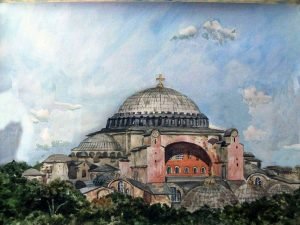 If a person researches the topic of “Spiritual Formation of Laity” that is contained in the second session of the Patriarchal Council of the Ukrainian Greek-Catholic Church, which was held in 1998, you will find something that was written by the Kyivan Grand Prince Volodymyr in the 11th-12th century. He shared with his people that Christian living must draw upon a person’s personal commitment to become like Jesus. His writing can inspire us today.
If a person researches the topic of “Spiritual Formation of Laity” that is contained in the second session of the Patriarchal Council of the Ukrainian Greek-Catholic Church, which was held in 1998, you will find something that was written by the Kyivan Grand Prince Volodymyr in the 11th-12th century. He shared with his people that Christian living must draw upon a person’s personal commitment to become like Jesus. His writing can inspire us today.
As we recognize the difficult history of the Ukrainian Greek-Catholic Church, we have to recognize her holiness and the absolute courageousness of her members during many difficult years. They are prime examples for us to imitate.
When the Kyivan Church entered into communion with Rome her spiritual heritage and her saints entered the communion with her. We can take pride and learn so very much from our Church’s past and also her experience in the catacombs of modern times.
We have to understand that the Ukrainian Greek-Catholic Church is of the Kyivan and Byzantine tradition and has its own Eastern theology and spirituality as well as worship practices. It is different from Western Catholicism. This difference, however, does not make us any less Catholic.
This, of course, raises the question: What does it mean to be Catholic? Does it mean that we have to have the very same theology and spirituality? Does it mean that we have to adopt all the liturgical practices and devotions of the Western Church?
To be Catholic means that we belong to a “communion of Churches” and recognize that, in accord with Sacred Tradition, we recognize the Patriarch of the West, the Bishop of Rome, as the first among equals who, like Peter, is called by God to keep unity among all the Churches. When you look at the history of the Church, you realize that Peter did not dictate to the other Apostles what to believe and how to worship God. (This is one reason why we have so many different forms of worship within the Catholic Communion). Each Apostle seems to have developed with the people he evangelized, a unique way to worship that had common elements.
What Peter also did was to make sure that all Apostles agreed upon some very basic beliefs. This was done by working to achieve “consensus” among the Apostles. The early Church governed itself through a Synodal approach – a gathering of all Church leaders and arguing and debating dogmas of faith and then eventually coming to a common consensus.
We know that after 1054 CE this was no longer possible and still is impossible. This will never be true again until Churches achieve “unity” and, of course, “communion.”
This is why our Church still maintains its own internal discipline, theology and spirituality. There is no “right” or “wrong” way. The way is directly connected to our history and traditions. Let us take pride in our own Tradition.
